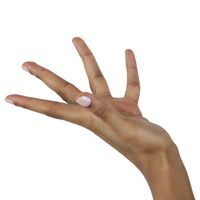Difference between revisions of "Alapadma"
Jump to navigation
Jump to search
(Application and Description Added) |
m (removed quotes, simplified to Krishna) |
||
| (2 intermediate revisions by 2 users not shown) | |||
| Line 5: | Line 5: | ||
}} | }} | ||
| − | '''Alapadma''' | + | '''Alapadma''' mudra, according to legend, originated from a story about Krishna as a child, in which he stole butter and milk. |
| − | + | ==Application== | |
| − | + | Alapadma mudra is one of the many hand gestures used by performing artists to express a specific action or emotional state. | |
| − | + | This gesture can also be used to depict the following: | |
| − | + | * Viraha (yearning for the beloved) | |
| − | + | * Mukura (mirror) | |
| − | + | * Tataka (pond or lake) | |
| − | + | * Udra-thakopa (great anger) | |
| − | + | * Shakata (cart) | |
| − | + | * fresh ghee | |
| − | + | * sweets | |
| + | * ball | ||
| + | * dancing | ||
| + | * palace | ||
| + | * cluster of flowers | ||
| − | |||
[[Category:Mudras]] | [[Category:Mudras]] | ||
Latest revision as of 20:54, 14 July 2013
| Meaning | Fully opened lotus |
|---|---|
Alapadma mudra, according to legend, originated from a story about Krishna as a child, in which he stole butter and milk.
Application
Alapadma mudra is one of the many hand gestures used by performing artists to express a specific action or emotional state.
This gesture can also be used to depict the following:
- Viraha (yearning for the beloved)
- Mukura (mirror)
- Tataka (pond or lake)
- Udra-thakopa (great anger)
- Shakata (cart)
- fresh ghee
- sweets
- ball
- dancing
- palace
- cluster of flowers
